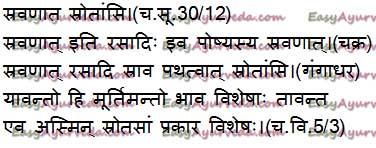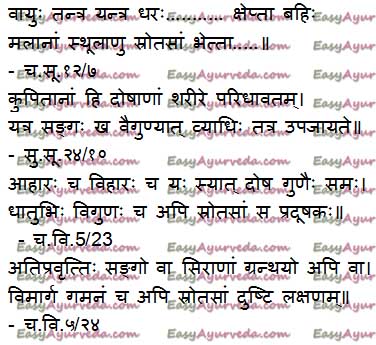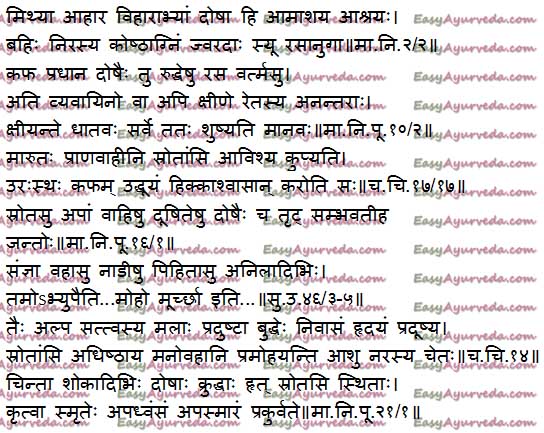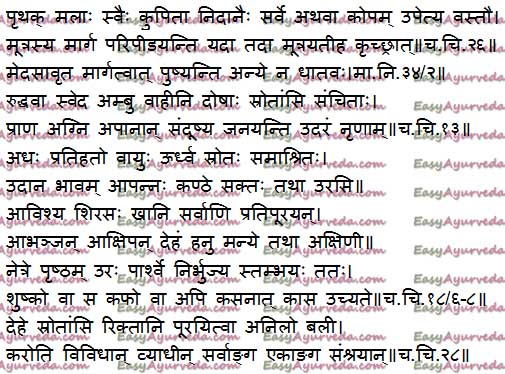Channels Of Circulation And Doshas
By Dr Raghuram Y.S. MD (Ay) & Dr Manasa, B.A.M.S
According to Ayurveda, entire human body is made up of many channels or ducts. These channels are of many shapes and size. They are called srotas.
Strotas are pathways through which tissues or building materials needed for formation of tissues flow. These channels also transport nutrients and oxygen to all places of body. Some channels transport food, some excrete feces, urine and sweat. Thus, channel systems of body serve many functions.
‘Number and types of channels present in human body are same as number and types of solid structures present.’
Read – Shaareera: Ayurvedic Study Of Anatomy And Physiology
This statement of Charaka explains that channels are innumerable in number and are scattered all through body, every structure, small or big is made up of and connected to these channels. In short, every structure in body is connected to other structures at different corners of body through these duct system.
Table of Contents
Srotas – Sanskrit Verse

Types of Srotas
Channesl of body are broadly classified into 2 kinds. They are –
Bahirmukha srotas – External channels of body open to exterior. They are 10 in number. They include – 2 openings of nose, 2 for ears, 2 in eyes, 1 in penis, 1 in mouth and 1 in anal orifice. 10th one is located in head. Women have 3 more orifices, 1 in each breast and opening of birth canal.
Antarmukha Srotas or Yogavahi Srotas – These are channels located inside body. They also have their openings within body and do not open on exterior.
According to Charaka, there are 13 types of internal channels –
- 1 each for carrying air / oxygen, food and water
- 7 for carrying 7 tissues (dhatus), 1 for each tissue
- 3 for excreting 3 types of excreta, 1 for each excreta (faeces, urine and sweat)
Sushruta has mentioned 11 pair of channels within body. They are –
- 1 each for carrying air, food and water
- 5 channels for carrying 5 tissues (no channels have been mentioned for carrying bone tissue and bone marrow)
- 1 each for carrying 2 types of excreta (channels for carrying sweat has not been mentioned)
- 1 channel for carrying menstrual blood and ovum (in women)
But what we can observe is that no specific channels have been mentioned for circulation of doshas i.e. vata, pitta and kapha. One may get a doubt so as to why are no channels specified for transportation of doshas while they are functional components of body. Read – Functions Of Doshas In Balance In The Body – Prakrita Dosha Karma
Srotas for Doshas
Do doshas have specific channels of transportation in body?
This is a golden question for all Ayurveda enthusiasts. Doshas are functional components of body. They maintain all functions of body without interruption when they are in a state of balance. But when they are disturbed they cause diseases. But to bring about normal functions or pathological conditions, doshas have to move from one place to other. For this to happen, they need channels. But Ayurveda classics have not mentioned any specific channels for transportation of doshas in the body. ‘Do doshas have specific channels of transportation in body?’ No, because specific channels are not mentioned in texts. Yes, because we have a reference wherein it is said that doshas move around in all available channels of body. Read – Types Of Doshas And Their Functions
Thus, doshas move around in all 13 types of channels enlisted above. They move through all small and big channels. Even among doshas, pitta and kapha cannot move all alone by themselves. They need to be mobilised and motivated by vata, which is driving force of all activities in body.

Classical references and examples to accept that doshas commute in all channels of body
1. Embryological evidences
Human body is made up of five elements of nature. It is obvious that all structures in body are made up of predominance of one or other element. Akasha Mahabhuta i.e. ether element is said to create coelomicity in body with its vivardhana kriya i.e. space creating function. This provides space for different organs, vessels and channels of body. Taking an extension of this example, it can also be inferred that space within channels and ducts is created by space element. Same space element along with air element helps in formation of vata dosha. Vata is responsible for movement of all elements in channels, including tissues, pitta, kapha and excreta. Thus, doshas have an inseparable relationship with channels of body. Read – Understand Vata Dosha By Its Functions
2. Anatomical and Physiological evidences
There is a reference which explains vata as a formula which controls machine called body. Among many functions of vata substantiating vata as a mastermind of all activities in body, I would like to quote a part of verse given by Charaka which relates vata to channels of body and substantiates embryological evidence.
Vata forms spaces and cavities required for accommodation of all big and small channels of body. Biggest space of body is called antah koshta, entire vacant space of body. This is basically occupied by many viscera, mainly gastrointestinal tract. Large space is called Mahasrotas, great channel of body. Read – Koshta – Large Anatomical Body Cavities
It is also said in this context that vata is responsible for expulsion of excreta from body. Excreta, including feces, urine and sweat are formed in caecum. Feces are later excreted through anus, which is a part of purishavaha stoats i.e. channels responsible for voiding feces. Caecum and anus are parts of colon and colon is chief operating seat of vayu. Thus, vata, as a dosha is related to defecating channels.
Similarly, urine is excreted through urinary bladder. Urinary bladder is a part of mutravaha srotas, urine forming and voiding channels. It is also a seat of apana vata.
Sweat is expelled from skin through swedavaha srotas, sweat carrying channels. sweat is thrown out through skin pores by action of vyana vata.
Dosha-tissue-excreta-channels relationship
Doshas are related to tissues in resident-residence relationship which is an ever-staying and inseparable one. Vata resides in bones. Pitta resides in blood and sweat. Kapha resides in lymph, muscle, fat, bone marrow, semen, feces and urine. Among these tissues and excreta, each one has their own channel of commuting in body. When these tissues and excreta move in their channels, it also means that doshas residing in these tissues and excreta also move in same channels. Thus, doshas are moving in all channels of body. Read – Ashraya Ashrayi Bhava: Relationship Between Tissues And Doshas
3. Pathological evidences
a. Stage of overflow of doshas and srotas
Shat Kriya Kala is earliest explanation of chronology of pathological stages of diseases ever known to medical science. This tells that any disease will manifest after a chronology of six events. Among them, third stage of pathogenesis is one in which doshas which have undergone increase through liquefaction in second stage of pathogenesis will leave their seats and overflow in all directions of body.
Doshas may move in upward, downward or lateral directions. These movements are called dosha gatis. Doshas will produce diseases in whichever direction they move, after getting lodged in tissues therein and damaging them in consecutive stages of pathogenesis. Example, when doshas move in upward direction, they tend to cause diseases like vomiting, diseases of ear, nose, eye, insanity, loss of memory, epilepsy, dyspnea etc. Similarly, doshas moving in downward direction will cause diarrhoea and when they move in lateral direction they may cause skin diseases. Read – Relationship between Samprapti and Shat Kriya Kala
Likewise doshas may take any one of below mentioned three courses and causes diseases therein. They are called vyadhi margas.
- Doshas moving into visceral organs i.e. koshta, they cause diseases like vomiting, colic, diarrhoea, constipation etc.
- Doshas moving in tissues i.e. shakas cause diseases like blood borne diseases, goitre, , impotence etc.
- Doshas moving in joints and vital structures of body i.e. marmasthi sandhigata causes heart ailments, insanity, urinary stones, diabetes, arthritis etc diseases.
If doshas need to move all around body, in all directions, in all courses mentioned above and produce diseases, they need certain pathways for their commuting. All channels of body form commuting pathways for doshas.
Among diseases produced during prasara stage of pathogenesis, few of which are mentioned above
- vomiting happens from stomach, which is a root of channels carrying food,
- diarrhea occurs from colon and anus, which are roots of excreta expelling channels
- dyspnea is caused by pathology occurring in lungs and heart, which are roots of air carrying channels
- skin diseases occur due to pathology occurring in rasavaha strotas or lymph carrying channels
- insanity, memory loss and epilepsy are caused in nervous system which are roots of channels carrying mind and thoughts
- obesity is caused as pathological manifestation of fat carrying channels, goitre due to muscle carrying channels and impotence due to vitiation of semen carrying channels
Doshas, as explained move in all these channels and cause these diseases. This is an evidence to show that doshas are related to channels of body from a pathological perspective.
Thus, dosha gatis are related to doshas. Doshas also cause diseases in all three vyadhi margas. Doshas, gatis and margas are all related and explained in terms of channels of body. Read – Yogavahi: How Vata Dosha Interacts With Pitta And Kapha
b. Disease formation, doshas and channels of body
Doshas which have undergone pathological increase following their vitiation travel all through body. While they are travelling, wherever they are obstructed due to kha vaigunya i.e. deformity of tracts and channels, doshas cause diseases at place of obstruction.
Here, vitiated doshas are travelling in channels of body. Deformity of channels also takes place due to obstruction of channels. Since doshas cannot move ahead at point of obstruction, they get lodged in tissues therein, damage them and cause diseases. This also establishes link between movement of vitiated doshas in channels, contamination of channels and formation of diseases. Read – Samprapti Vighatana – Breaking Of Pathogenesis Meaning, Importance
c. Etiological factors of diseases, channels of body and dosha link
Charaka quotes common causes for vitiation of all srotas as below mentioned –
- When foods and activities which have similar qualities as those of doshas are consumed, they aggravate doshas. These doshas later contaminate body, damage tissues and cause various diseases. Since doshas contaminate tissues they also vitiate channels because tissues are carried in their respective channels of transportation.
- When foods and activities which have antagonistic i.e. have opposite qualities as those of tissues are consumed, they cause damage of tissues. Channels of body transport tissues. When damaged and contaminated tissues are flowing in channels, they contaminate and vitiate channels also leading to wide array of diseases.
Among these causative factors, first one clearly establishes relationship between doshas and channels of body.
d. Doshas and common symptoms of channel vitiation
Common symptoms of Srotas vitiation are –
- Ati pravrutti – Excessive discharge / flow, as occurs in watery stools in diarrhea
- Sanga – Obstruction, as in constipation, accumulation of phlegm in lungs etc
- Sira Granthi – Formation of masses like tumours, cysts etc
- Vimarga gamana – moving in wrong directio as in vomiting etc
Signs and symptoms of individual channel vitiation will be categorised under one of above. But in all these cases, these symptoms of vitiation of channels are caused by vitiated doshas. Read – Allergic Rhinitis: Causes, Remedies, Ayurvedic treatment, Herbs

e. Examples of dosha relationship with contamination of individual channels and formation of diseases therein
Contamination of lymph and food carrying channels by doshas in pathogenesis of fever
In pathogenesis of fever, it is said that doshas aggravated on consumption of unwholesome foods and activities get accumulated in stomach. Doshas get admixed with rasa i.e. nutritive juices formed after digestion of food and lymph formed from them. Doshas mixed with lymph spread all over body displacing metabolic fire from its place i.e. stomach and cause fever. In this instance doshas spread through channels of transportation of lymph and nutritive juices i.e. rasavaha srotas. Stomach is seat of origin of fever. Stomach is a part of great channel i.e. mahasrotas of body and part of food carrying channels i.e. annavaha srotas. Thus, in this instance, doshas are related to rasavaha, annavaha and maha srotas. Read – Annavaha Srotas – Channels Of Food Transport
Contamination of lymph carrying channels by vitiated doshas in pathogenesis of tuberculosis and all channels of tissues in later stage of disease
Blockage of rasa (nutritive juices) carrying channels by morbid kapha predominant doshas is said to be one of the main pathological process leading to causation of rajayakshma. Rajayakshma is known as king of diseases and is often compared to tuberculosis. In this disease all channels are blocked by morbid doshas in later stages leading to destruction of tissues. Doshas are related to rasavaha srotas in this instance.
Blockage of channels carrying air by morbid doshas in causation of hiccough and dyspnea
Pathogenesis explained in context of hiccough and dyspnea diseases points towards doshas occupying and contaminating channels responsible for transporting air i.e. pranavaha srotas.
‘vitiated vata on occupying and getting trapped in pranavaha srotas gets further vitiated. This vata further exacerbates kapha located in chest and causes hikka and shwasa’.
Contamination of water carrying channels by doshas in pathogenesis of thirst disorder
Similarly vitiated doshas contaminate udakavaha srotas i.e water carrying channels and cause thirst disease.
Blockage of conscious carrying channels by doshas in causation of fainting diseases
‘vitiated doshas occupy consciousness carrying channels, contaminate them and cause diseases like fainting, delusion, confusion, ignorance and loss of consciousness’. Read – Ayurvedic Treatment For ADHD – Herbs, Therapies, Medicines, Remedies
Affliction of channels of mind faculties in pathogenesis of insanity
‘In people who have weak and debilitated mind, vitiated doshas contaminate brain which is an abode for intelligence, occupy manovaha srotas i.e. channels carrying mind faculties and damage them and cause insanity after clouding mind and consciousness’.
Block of channels of brain by doshas in pathogenesis of epilepsy / memory disorders
Similarly apasmara i.e. loss of memory / epilepsy is caused when doshas afflict hrit-srotas i.e. channels of brain and destroy memory of an individual. Read – Autism – Ayurveda Perspective, Management Principles

Doshas blocking channels of urine transportation in pathogenesis of dysuria
Doshas either individually or all together are said to afflict urine carrying passages and cause difficulty of urination. Read – Dysuria: Causes, Remedies, Tips, Diet, Ayurvedic Treatment
Block of multiple channels and channels for transportation of fat by doshas in pathogenesis of disorders of fat metabolism
In case of diseases caused due to errors in fat metabolism i.e. medoroga, it is said ‘channels of body do not nourish any tissue in body except fat when they are blocked by fat’. Channels of fat are obviously blocked by ama and morbid doshas. Read – Weight Loss, Weight Gain Treatment, Sleep – Charaka Sutra 21
Involvement of doshas and channels of water and sweat transportation in abdominal disorders
Pathogenesis of abdominal disorders i.e. udara roga is explained as – ‘doshas accumulated in body, over a period of time block channels transporting water and sweat in body, contaminate prana vata, digestive fire and apana vata and cause many kinds of abdominal disorders’.
Doshas afflicting multiple channels in pathogenesis of cough
Affliction of multiple channels when one group of channels is afflicted by doshas and consequent involvement of entire body in disease process is explained in below mentioned contexts –
Pathogenesis of cough
‘vata blocked in lower portions of body moves through channels reaching upper parts of body and reach upper body. On associating with udana vata, vata gets impacted in throat and chest. Later vata moves in channels of head and fills all channels.
This vata later destroys entire body and creates trembles, especially afflicting jaws and neck and eyes. Vata causes bending, distortion and stiffness in region of eyes, back, chest, and sides of body. Doing so, it causes cough of dry or wet form.’
Here we can see that vata occupies many channels of upper portion of body and head. We can also observe that entire body is damaged and distorted. This is an example of multiple channel involvement.
Read – Charaka Kasa Chikitsa – 18th Chapter
Doshas afflicting many channels in pathogenesis of vata vyadhi
Similar example can be found in explanation of pathogenesis of vata vyadhi i.e. vata disorders.
‘severely vitiated vata occupies all empty channels of body and causes many diseases afflicting a portion of body or entire body’.
This is another example of multiple dosha afflictions by morbid doshas causing diseases and pathology throughout body.
Read – Vata Disorders (Vatavyadhi): Definition, Causes, Symptoms
Evidence from treatments
4. Evidences from ‘treatment strategies and basics’ of diseases and doshas
a. Opening up and cleansing channels to revert pathological transit of doshas
In normal individuals who are healthy there is regular transit of doshas from tissues to visceral organs and vice versa. This movement is necessary for maintenance of normal functions of body and organs. We know that tissues and doshas have residence and resident relationship. The tissues are residence and doshas live in them. Doshas move from tissues into organs to conduct normal functions like digestion, circulation etc. This is normal transit of doshas. If there is imbalance in this to and fro movement of doshas and when doshas do not return to visceral spaces to conduct normal functions, doshas get stagnated and localised in tissues. Doshas thus left over will damage tissues in long run. This is main cause of all systemic diseases.
Thus, when doshas move from tissues into visceral spaces they conduct normal functions and help in maintenance of normal physiology and health. On other hand, when doshas move from visceral spaces into tissues and do not return, they cause diseases. This causes diseases. Both these movements of doshas take place through channels of body. Read – Chikitsa: Treatment Types, Ayurvedic classification
One of causes for pathological transit of doshas i.e. from visceral spaces into tissues is said to be quick action of vata. Vata pushes doshas into tissues.
Among interventions, morbid doshas need to be brought back from tissues into viscera and eliminated from therein. Among many strategies to bring doshas back to visceral spaces i.e. to stomach, srotomukha vishodhana i.e. expansion of lumen and openings of channels of the body is main. In pathological transit of doshas, channels are blocked. When channel cleansing measures are adopted, pathways become clear so that doshas easily flow into stomach. This would enable doshas from coming back into stomach. Increasing doshas in tissues, liquefaction and digestion of doshas and control of vata will all help in mobilizing doshas from tissues to visceral space of stomach from where they can be easily eliminated by administration of shodhana i.e. cleansing treatments, mainly therapeutic emesis and purgation.
All these explain relationship between doshas and channels of body in therapeutic interventions.
Since entire body is made up of channels of different shapes and sizes, diseases are also caused due to contamination of these channels by doshas. Cleansing of same channels will bring back equilibrium of body and establish health.
b. Shodhana – elimination of doshas
Shodhana means cleansing treatments. These treatments are preferred to throw away unwanted metabolic wastes and tissue toxins out of body.
After bringing doshas back to stomach from tissues, doshas are eliminated from body. If doshas are predominant in kapha, they are eliminated through emesis. Kapha doshas are removed through mouth. If doshas are predominant in pitta, they are eliminated through purgation. Pitta doshas are removed through anal route Vata is eliminated from anal route through therapeutic enemas.
All these purification methods of treatment also occur through channels of body. Emesis, through which kapha is removed, occurs from stomach which is root of food carrying channels. Purgation, through which pitta is removed, occurs from intestines which are roots of feces carrying channels.
Click to Consult Dr Raghuram Y.S. MD (Ayu) – Email / Skype










